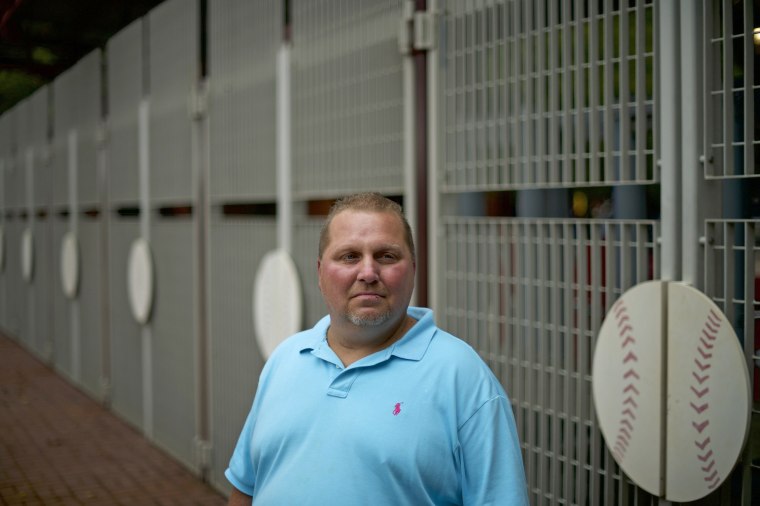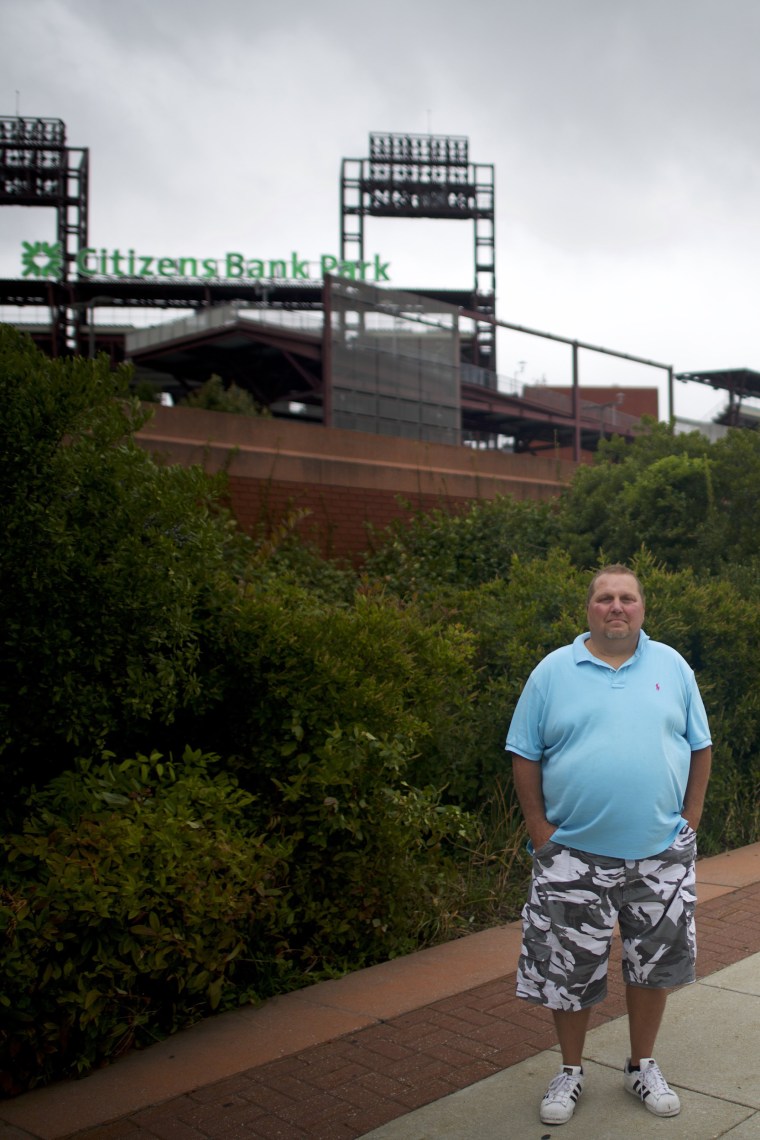Dwayne Sowa scored good seats to watch his beloved Mets play the Phillies in an early season game at Philadelphia's Citizens Bank Park in 2014. He and his wife were sitting just past third base and 18 rows from the field in section 134.
In the bottom of the sixth inning, as he turned to pay a vendor for a beer, a foul ball off the bat of Phillies star Jimmy Rollins slammed into the right side of Sowa's forehead.
"My wife heard it," he recalled. "It was the worst noise she's ever heard — the crack of my skull."
Sowa never lost consciousness, but he needed surgery to fix a crushed bone above his right eye. He is still suffering lingering side effects.

If he had been sitting a few feet closer to home plate, the accident might never have happened. At Citizens Bank Park in Philadelphia, netting that stretches from first base to home plate and then from home plate to third base protects fans from foul balls. But there was no netting for the fans in section 134 in May 2014, just as there is no netting all the way down the first and third-base lines to the foul poles at most of Major League Baseball's 30 ballparks. Sowa is far from the only fan to be injured by a foul ball while watching big league ball from a "good" seat.
An NBC News investigation found at least 808 reports of injuries to fans from baseballs from 2012 to 2019. The injuries include concussions and permanent vision loss. In 2018, a grandmother celebrating her 79th birthday at Dodgers Stadium in Los Angeles died after being hit in the head by a foul ball. Most of the injuries resulted from fouls. Some are from home runs and batting practice. In other cases, fans were injured as they scrambled to catch balls flying into the stands.
Though baseball is synonymous with statistics, where fans can trace the placement of every pitch and home run, Major League Baseball, along with the 30 teams declined NBC News' requests for information about the number of incidents and injuries at their ballparks. Some teams said they don't track that data, others said it was a privacy issue.
The NBC News tally is based on lawsuits, news reports, social media postings and information from the contractors that provide first aid stations at MLB stadiums.
Only four agencies at four parks provided records of their emergency responses to baseball fan injuries, but those four alone provided 701 reports of injuries from baseballs hit into the stands. NBC News found an additional 107 reports of people being hit by balls since 2012 after combing through lawsuits, news reports and social media postings involving all 30 MLB teams, for a total of at least 808 reported injuries.
Bob Gorman, author of "Death at the Ballpark," said the number of fan injuries is likely much higher.
"I think the number is a lot higher than people realize. I think the teams know it," said Gorman, whose book is a comprehensive history of fatalities at ballparks. "I think they've intentionally downplayed it."
The physics of getting struck with a baseball can be brutal. Baseballs are hard, weigh about five ounces and are nine inches around, roughly the size of a fist. And in the major leagues, they can fly off the bat of the best hitters at more than 100 miles an hour. At that speed, they can strike a fan about a second after leaving the bat.
Garrett Jones, an eight-year veteran of major league baseball, knows first-hand the agony of seeing a foul ball hit a fan. The former first baseman for the Pittsburgh Pirates hit a line drive foul along the first-base side into the stands at a May 25, 2013, game. The ball hit a little boy.
"It crushes you. It really hits you in the heart," Jones said. "I mean, you just feel awful."
The boy, he was told, turned out not to be seriously hurt. But even with his skills as a top-level professional player, Jones questions whether, as a fan in the stands, he could catch a line drive headed his way.
"Even if I'm watching a game, and a 105 mph foul ball comes at me, and I'm ready for it, there's still a good chance I could miss it," he said.
The conditions of the ballpark and the technology of the game have changed. The players are stronger, the pitchers are throwing faster, and the balls are coming off the bat harder. Data compiled for NBC News by the Elias Sports Bureau shows the number of foul balls per game has increased 10 percent since 2000.
Even MLB insiders acknowledge that for fans, paying attention to every moment of a game is almost impossible. Hot dog vendors pass by. Fans cheer. Instant replays flash on large screens. Scoreboards rattle off statistics and scores. And of course, the emergence of smartphones has many fans looking down at their hands when they used to have their eyes on the field.
Brooks Boyer, a senior vice president for sales and marketing for the Chicago White Sox, says it is unrealistic to expect fans to pay attention for the entirety of the game. "We have digital boards giving [fans] all sorts of information, and the cadence of baseball allows you to have a conversation and doesn't require you to have 100 percent attention to what's going on in the field."
In December 2015, MLB released a recommendation that teams provide expanded netting and shield seats 70 feet down both foul lines from home plate. Only a few teams did so at that time. It wasn’t until September 2017, after a little girl was severely injured by a foul ball off the bat of Todd Frazier at Yankee Stadium, that the rest of the teams extended their protective netting.
This season, the Chicago White Sox were the first major league team to extend protective netting even further — all the way to the foul poles — and the Atlanta Braves announced they would follow suit.
The Philadelphia Phillies told NBC News exclusively they are going to extend their netting to the foul poles by the 2020 season.
So far, a total of 13 teams have announced a further extension of netting. Six teams announced an extension this season — the White Sox, Braves, Washington Nationals, Baltimore Orioles, Los Angeles Dodgers, and Houston Astros. The other seven teams — the Arizona Diamondbacks, Kansas City Royals, Milwaukee Brewers, Pittsburgh Pirates, Texas Rangers, Toronto Blue Jays and the Philadelphia Phillies — have all committed to extending their netting by the 2020 season.
Seventeen teams have not announced any plans to make additional extensions to their netting. Of those 17, some already have netting that extends past the home and visitor dugouts, but none have netting that extends to the foul poles.
Dwayne Sowa, meanwhile, says that five years after he was hit by the foul, his life is a struggle — "a struggle for me mentally, a struggle with my marriage, a struggle with everything." He says he has headaches and sudden bursts of rage that require medication.

He had hoped to get help from the Phillies after his injury, but instead, after reaching out to the team numerous times, all he got from them was what he could fit into the palms of his hands — a baseball signed by Jimmy Rollins and two tickets to a Phillies game.
Sowa pursued legal action. "They told my attorneys: '[We] gave them one game,' as though that compensates for everything," he said.
But he dropped his case, he said, because his attorney told him "it's not going to go anywhere."
His attorney was referring to liability protection under the so-called "Baseball Rule," a legal doctrine dating back to the early 1900s that makes it difficult for spectators to sue professional teams over injuries. A disclaimer on the back of every ticket reads that "the ticketholder assumes all risk, danger and injury incidental to the game of baseball..."
Sowa has only been back to the ballpark once since that day in 2014 when the ball cracked his skull. He sat high up, far from the field, but said he was still uncomfortable and hasn't returned.
But the news that the Phillies will be extending their foul screen next season, he says, may change his mind about baseball, and about taking his five-year-old to a game.
"I thought I'd never take him, but to sit where there's netting, I'll feel safe taking my son again."
He's hoping all 30 teams will extend their protective netting to the foul poles so other fans won't have to face the same risks when watching America's pastime.
How we got our data
NBC News reached out to all first aid stations that contract with the 30 MLB ballparks and asked for emergency response records of fan injuries caused by foul balls. Only four agencies from four stadiums provided data: Marlins Park (Miami), Oakland Coliseum, Coors Field (Denver) and T-Mobile Park (Seattle). Some of the first aid stations said they do not track injuries from baseballs. From the agencies that provided data, we received records dating back to 2012, except for Coors Field, which had numbers starting in 2014. The first aid agency at Coors said its data was not calculated the same way before 2014, so there was no way of isolating injuries from foul balls. Tallying data from just these four stadiums, there were a total of 701 reports of injuries from baseballs. NBC News also found an additional 107 reports of people hit by baseballs since 2012 after combing through lawsuits, news reports and social media posts, for a total of at least 808 reported injuries. A majority were from foul balls; others were from home runs. We also included reports of injuries from balls during batting practice and injuries to fans as they tried to catch balls flying into the stands.
